A big part of being prepared is being ready, genuinely ready, to react to trouble, whatever form it might take.
You could be facing a personal crisis, a natural disaster or a man-made catastrophe with little to no time to plan, much less gather needed equipment. For that reason, when trouble strikes and you need to shelter in place you need a 72-hour kit.
A basic 72 hour kit is a good minimum level of preparedness. In case of a severe winter storm, hurricane, or some other event that disrupts normal life a good emergency kit will be extremely welcome. These kits can be put together for friends and family as well and given “just in case.”
The 72-hour kit, as the name suggests, is designed to help someone survive and sustain life for 72-hours, 3 days, by providing them with survival necessities or the tools to obtain them, regardless of environment and circumstances.
It is sort of a combination parachute and survival scuba tank for living and working through a disaster or crisis in any environment.
This type of kit is always a personally curated collection, but each and every one of them will have a core of basic life support gear that will be further built upon by the individual assembling it.
To help you get off on the right foot when assembling your 72-hour kit, will be providing you with a checklist and overview of the core components below.
The 72-Hour Checklist
You can get the PDF version here.
- Shelter
- Lightweight Tent
- Bivouac Sack
- Tarp
- Cordage
- Fasteners
- Sleeping Bag
- Ground Pad
- Blankets
- Clothes
- Shirts
- Pants
- Socks and Underwear
- Outer Shell
- Headgear
- Sunglasses
- Gloves
- Shoes or Boots
- Hydration
- Water
- Water Filter
- Sterilization Chemicals
- Water Bottle
- Hydration Bladder
- Ziploc Bags
- Cooking and Food
- MREs
- Protein / Granola Bars
- Water Bottle with Water
- Cup or Mug
- Small Portable Stove
- Fuel
- Field Tools
- Knife
- Hatchet
- Multi-tool
- Saw
- Lighting
- Flashlight
- Headlamp
- Batteries
- Candles
- Chemlights
- Fire Kit
- Bic Lighters
- Waterproof Matches
- Ferro Rod
- Tinder
- Navigation and Comms
- Maps
- Compass
- GPS
- Cell Phone
- Radio / Walkie-Talkie
- Charger / Batteries
- Medical and Hygiene
- Gauze, roll and pad
- Gauze, hemostatic
- Band-aids
- Wound wash
- OTC Meds
- Prescription Meds
- Latex Gloves
- TQ
- Toothbrush and toothpaste
- Soap
- TP / Baby Wipes
- Foot and Body Powder
- Hand Sanitizer
- Feminine Hygiene Products
- Weapons
- Handgun
- Long gun
- Ammo w/ Feeding Devices
- Cash
A Good 72hr. Kit is More than Food and Water
When considering a 72-hour kit, a common mistake that some preppers make is overloading on consumables, specifically food and water.
Though undeniably critical during a survival situation, there is much more to worry about than just those two provisions no matter how important they may be. Other survival necessities, if neglected, can result in disaster and death just as quickly or quicker.
Specifically, gear and other supplies to help combat exposure will be absolutely essential in virtually every environment.
Even in your own home, if power is out or gas supplies are cut ambient conditions inside can get bas quickly! If conditions are hostile enough, exposure can incapacitate or kill you in as little as a few hours. Bringing along enough clothing and specialized shelter gear to help ward off this unhappy fate is vital.
Beyond even the survival necessities other gear will prove to be important as well. Navigational aids, communications gear and weapons for self-defense are all important inclusions.
Naturally, everything that you choose must be balanced against a weight budget, further complicating matters. a 72-hour kit must be robust and complete but also lean enough so that it does not unduly burden the carrier in case evac is required.
I’ll include advice throughout the article under each entry that will help you make informed decisions based on your personal requirements. Now it’s time to get to the list!
Checklist Breakdown
The following items that should be included as the core of your 3-day kit represent a basic cross-section of gear, supplies, and other items that will fulfill various survival needs, but it should not be construed that this list is set in stone.
Any item that you need that is highly relevant to your requirements or your specific environment should be included, and any items listed below that are useless for your purposes should be omitted. As always, use your head and feel free to modify as required!
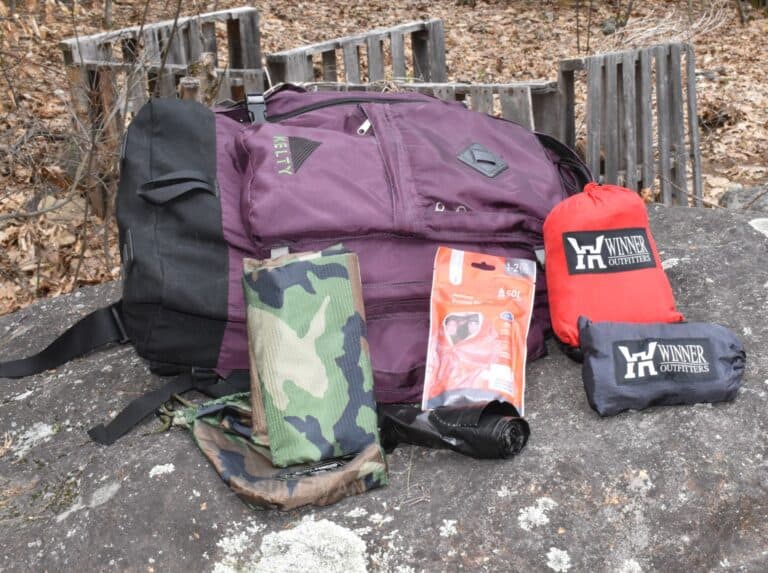
Shelter and Clothes
Shelter is among the most critical of survival necessities, coming in second right after air in importance. As I alluded to above, if you were trapped in bad conditions with the wrong factors working against you, you can succumb to exposure in as little as a few hours, even far away from the coldest regions on Earth.
For instance, if you are soaked with water or just from perspiration and are exposed to chili temperatures with a good, stiff wind, your teeth will be chattering in no time, and hypothermia will be following hot on its heels. Imagine how much worse it will be if you are in a decidedly cold environment.
Also, protection from heat and direct exposure to the sun is similarly important, but the prescription for avoiding becoming a heat casualty is usually just dressing appropriately and avoiding strenuous activity during the hottest part of the day.
Your shelter compliment should also include regionally and seasonally appropriate clothing from head to toe in addition.
Shelter Supplies
Lightweight tent: a lightweight tent, especially one that does not have to rely on a bulky apparatus of frame components, is an excellent inclusion in any 72-hour kit. the ability to quickly and reliably erect a “microclimate shelter” inside your own home that will provide warmth, or if outdoors, protection from rain, sun and some insulation from cold is invaluable.
Bivouac sack: In lieu of a tent one might choose to carry a bivouac sack, or bivy sack. Essentially an ultra compact tent barely big enough for one to lie down in, it nonetheless provides many of the advantages of a traditional tent and a much smaller and lighter package.
Especially suitable for relatively mild environs.
Tarp: a high quality, waterproof tarp with strong grommets is another invaluable inclusion to your shelter compliment.
Capable of being fashioned into a variety of shelter solutions in various environments, it also serves additional duty as a ground cover, windscreen, sun shade, roof patch and more. Ultralight and compact, definitely include one and consider a double-sided model with a camouflage side and a high-vis side for signaling.
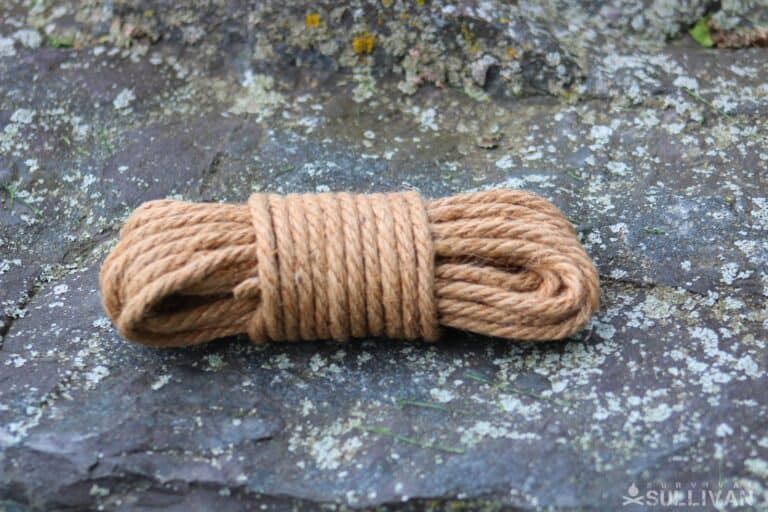
Cordage: Cordage is a perennially useful inclusion in any wilderness or urban survival kit. Although it has countless uses, we will predominantly use it for erecting and stabilizing shelter solutions, be they natural or provided by other carried gear, or repairs around the property.
Paracord is a ubiquitous and ultra strong option, but lighter and thinner cord such as accessory cord is also viable. Just make sure you have some!
Fasteners: a variety of specialized fasteners can make setting up shelter and conducting repairs faster, easier and more reliable in any environment.
I particularly like to have a variety pack of zip ties on hand as well as lightweight screw type tent stakes. When you are already tired and the sun is getting low in the sky, these cheater options will help you get meaningful rest quicker.
Sleeping Bag: In particularly cold environments or seasons a sleeping bag is mandatory, even with the addition of a tent or bivy.
A properly rated sleeping bag will keep you toasty warm and as snug as a bug despite harsh outside conditions. Though bulky and oftentimes expensive, a sleeping bag is an automatic inclusion in many environments. Consider spending more for a high-end, compact model if weight and overall size is a concern.
Ground Pad: Sleeping on the ground or floor, even with a sleeping bag, will usually prove to be an uncomfortable experience, not to mention the ground acts like a giant heat vacuum that will quickly chill you.
Make yourself more comfortable and better insulated by tossing in a lightweight but energy efficient ground pad with your sleeping bag.
Blanket: For additional insulation or primary insulation in milder environments a blanket will suffice. Choose either a standard household blanket or one of those crinkly, foil emergency blankets. The latter, sometimes called a space blanket, is anything but a novelty as they are highly efficient and effective at keeping users warm.
Clothes
Shirt: Your shirt should be seasonally appropriate, quick drying and suitable for use in a hard-working survival setting. Your 72-hour kit should include a spare shirt even if you are typically dressed and worthy clothing day to day.
Pants: Your pants, like the shirt outlined above, should be seasonally and climate appropriate, tough, quick drying and feature a multitude of pockets for convenience. Again, I recommend you include a spare pair in your 72-hour kit even if your daily wear is up to the task.
Socks and underwear, x2 each: It might sound like you are packing for a vacation, but a spare pair or two of underwear and socks will go a long way towards keeping you comfortable, clean and dry during an excursion or hard work.
Far from a nicety, both your feet and your nether regions are disproportionately likely to suffer when kept hot and humid when working hard, so the ability to change clothes is important for performance in addition to morale.
Outer shell: An outer garment, be it a coat, windbreaker, parka or something else, should be capable of providing resistance to wind and mild inclement precipitation. This garment should be donned or doffed as necessary except in the coldest environments.
Think twice before omitting this inclusion if you live in an arid environment, as nighttime temperatures as well as wind could make hypothermia a hazard.
Headgear: A good survival hat will help keep you warm and also feature a full brim to help keep the sun off of you. In colder environments, a beanie or sherpa hat may be a better inclusion.
Sunglasses: Eye protection is always imperative in a survival scenario. Protection from the sun’s rays, flying debris or just dense, prickly brush, choose a pair that will cover all of your bases and hold up to abuse. Leave the stylish, fashion shades behind.
Gloves: The world will present your hands with many injurious hazards, and rarely more often than in the middle of a survival situation. Jagged, torn metal, nails in splintered rafters or aggressively thorny plants and sharp rocks, it makes no difference.
Protect your hands by choosing a sturdy pair of gloves capable of doing work, and consider an over glove or mitten in a cold environment.
Boots or Shoes suitable for field/work use: Footwear is just as important as the rest of your clothes. You should choose sturdy hiking or trail shoes or lightweight boots that are at home in any environment.
This is one item that you can omit if you habitually wear such shoes or boots day in and day out, but if you do not, make sure they are included with the rest of your 72-hour kit.
Hydration
Many preppers are disproportionately focused on water as a survival resource, but that is with good reason. you can only go a couple of days, as a rule, without water before you perish, and it is exceedingly likely that you’ll be incapacitated a long time before then.
Therefore, assuring you have reliable access to good drinking water is imperative. To complicate matters, you should count on your local water supplies being offline or compromised during the event.
There is a lot of water around us and most parts of the world, but not all of it is good for drinking as is, or rather you can only drink it with fairly significant risks to your health.
Waterborne parasites and germs can make you gravely ill and further hamper your efforts to survive. The hydration component of your 72-hour kit therefore includes a small supply of drinking water on hand, a means to carry it and resources for purifying any naturally sourced water.
Water, 2 Liters per adult, per day, minimum: This is the minimum level of water needed by the average adult, per day, for hydration. Your actual requirements will very slightly depending on your activity level, climate, overall health and innate biological factors.
Your 72-hour survival kit should include this supply of water on hand so that you’re able to hydrate immediately and with certainty, but note that water is extremely heavy should you need to bug out.
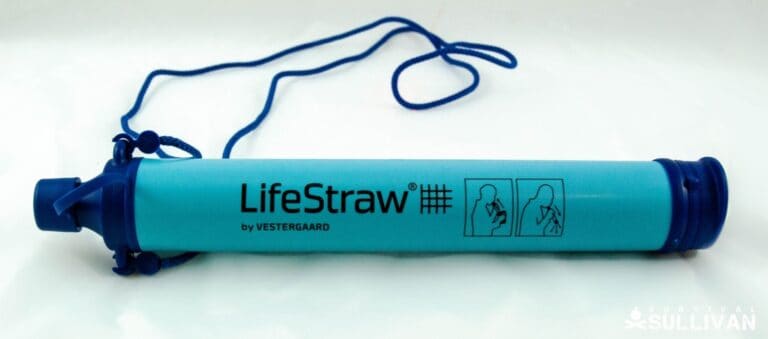
Water Filter: A compact, lightweight portable water filter will be quite literally worth its weight in gold in the middle of a survival situation. The best models in this category can virtually eliminate all dissolved solids, germs and parasites from drinking water, leaving you with crystal clear, fresh H2O.
Note that most filters small enough and light enough to warrant inclusion in your kit (for portability) will not remove heavy metals or certain chemical contaminants.
Sterilization Chemicals: For certain things that a water filter cannot do, or as a supplement to a filter, include sterilization chemicals in tablet or liquid form as a part of your kit.
There are many types of chemical to choose from and all have their pros and cons as well as differing instructions for use, and so we will avoid a detailed discussion here. Many will change the taste of your water for the worse, but it is a better deal than getting terribly sick.
Water Bottle: You’ll need a way to carry your water, and most preppers today choose from any variety of high quality, high impact water bottle on the market. easily able to stand up to rough handling, jostling and the occasional drop you won’t have to worry about leaks or loss with a good bottle.
One with a narrow neck is easier to drink from, but a wide mouth version is easier to fill. Note that if you choose a steel bottle without a liner it might rust if you don’t take care of it but it will also allow you to boil water inside the bottle if required.
Hydration Bladder: For the ultimate in convenience and portability, a hydration bladder installed in a backpack will allow you to carry more water than you could using bottles alone while also drinking from it freely on the move, no hands required.
Often fussy to fill and usually difficult to clean and keep fresh, nonetheless some folks prefer these over traditional bottles.
Ziploc Bags: Gallon-sized Ziploc brand freezer bags should be a part of every survival kit because of their sheer usefulness, but I’ve included them here because they are ideal for carrying additional water with you in a virtually leak proof container.
For gathering water prior to purification or bringing along some extra on a long stretch of travel, these are perfect.
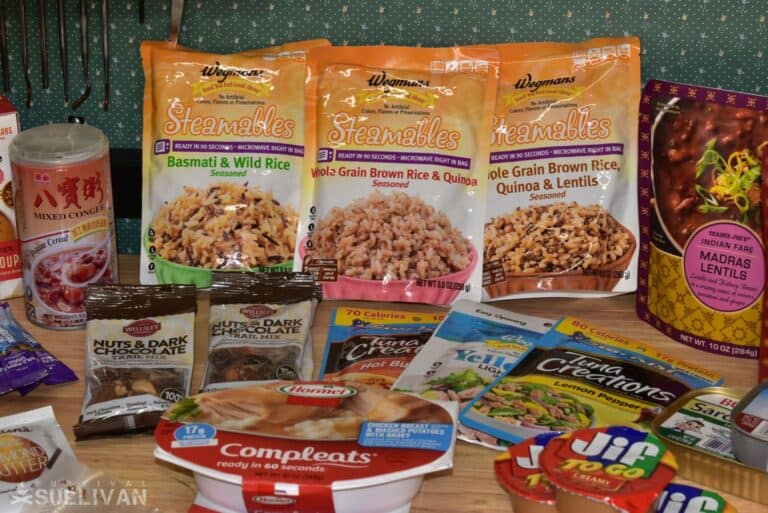
Food
Food is another critical survival essential, although one that is disproportionately grounded in emotion for most of us, rather than legitimate need. you can go weeks without a bite of food before you die, although a deteriorating mental and physical state will significantly impair your efforts to survive before that.
Nonetheless, it is easy enough to keep on trucking if you have the willpower even when rationing calories. Food, for our purposes, is included to maintain high energy levels and keep your head in the game. hopefully you have returned home or escaped danger by the time your food supply runs out.
All of your food must be shelf stable and durable or contained in a highly durable container, and preferably require no or minimal preparation before eating. A mix of proteins, carbs and fats will keep your energy levels topped out and help keep you satiated.
Meals: Appx. 2,000 calories per adult, per day. Meal options can run the usual gamut from food in cans or foil pouches to dehydrated camping meals or even MREs.
I particularly like MREs for this purpose since they are the ultimate in extremely calorie-dense durable food that is unlikely to spoil in long-term storage. Take the time to break down the MRE out of its main pouch in order to save more room in your pack if you need to run out the door.
Snacks: Snacks are an important inclusion in your 72-hour kit. They should be convenient, calorie dense and easily capable of being eaten on the go if you are working or evacuating.
Trail mix, energy bars and similar foods are all good options. Hard candies and jelly beans are also worth consideration as are pre-workout gels, and anything sweet and tasty is a great morale booster, especially for kids.
Beverages: Beverage powder in the form of electrolyte drink mix, instant coffee, tea and the like is a worthwhile inclusion for morale and quick energy uptake during a rest. Whatever it is, make sure it is easy to prepare without wasting too much water or fuel.
Mess Kit: A small mess kit should be included as part of your food compliment. A disposable plates or bowls with lightweight utensils is pretty much all that is required.
Cup or Mug: Include a metal, unlined cup or mug both for drinking and preparing food on your stove. Remember that this can be used for boiling water, also, for any purpose. This might be a bulky inclusion but a proper one will be very lightweight and add little to your load.
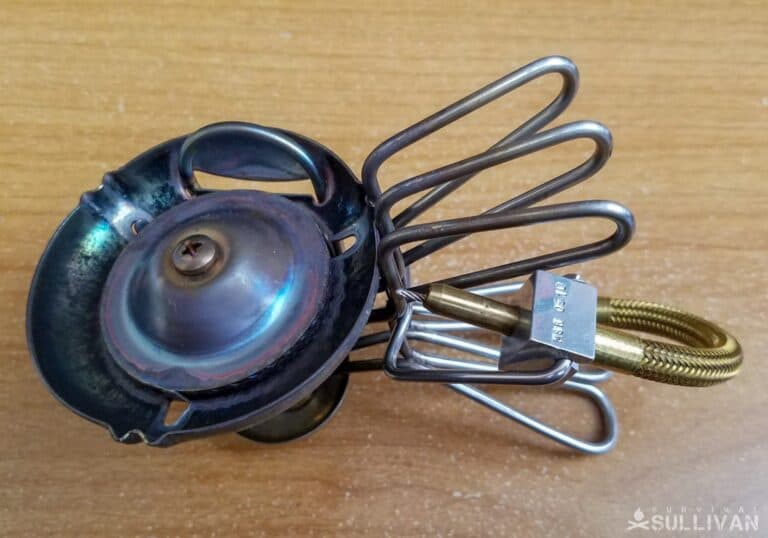
Stove: A small camp stove is a lightweight and worthy inclusion to your 72-hour kit. Time is often of the essence in a survival situation, and anything you can do to save time and labor for required tasks is worth considering.
I prefer the fold flat wood burning field stoves as they can use a variety of fuels and I don’t need to carry fuel with me, but some preppers may yet desire a more traditional, liquid-fueled or charcoal grill.
Fuel (if required): If you are one of those people who prefers a propane or alcohol stove or burner, make sure you keep your required stuff on hand, and use it sparingly.
Field Tools
You’ll have a surprising amount of work to do during a survival situation, and I can promise you it won’t be all sitting around waiting for help to arrive. Naturally, having the right tools can make this work far faster and easier, saving you energy and precious time.
Some outlets go overboard with the advice on tools, urging readers and would be survivors to obtain a veritable tool chest, but this is a non-starter for a 72-hour survival kit because tools are oftentimes expensive and can be bulky. It is far better instead to have tools that are universally useful, mobile and multi-purpose.
Knife: No prepper worth the name should ever go without a trusty knife. A stout fixed blade or a strong folder can both do the job, and you’ll use it for innumerable tasks, everything from preparing firewood and fashioning shelter to desperate self-defense in a pinch. Get one, keep it sharp and keep it close.
Hatchet: The hatchet is second in importance only to the knife when it comes to survival tools, particularly in outdoor environments.
Much smaller, lighter and ostensibly less capable than a full-sized axe, the hatchet is nonetheless entirely adequate for the vast majority of wood processing and chopping tasks. It also makes for a ferocious weapon in close-quarters combat.
Multi-tool: A good multi-tool can replace an entire pouch full of standalone, specialized ones. With strong pliers, a variety of driver bits and other useful attachments, your multi-tool can help you deal with anything that your knife and hatchet cannot, and help you maintain your gear in the bargain.
Saw: For some, a classic handyman saw or lightweight folding saw will be a replacement for a hatchet, but for folks living in densely wooded territory it might be included as a supplement.
For certain processing tasks and dealing with certain hardwoods a folding saw can be more efficient than a hatchet, and generally a folding saw has far less risk of accident in use than a hatchet does.
Lighting
Human beings don’t do well in the dark, but you might not have any choice in the matter when it comes to when you are traveling or working in the middle of a survival situation. Naturally that means you’ll want to include the preeminent personal lighting tools of our day in your 72-hour kit.
There is such a plethora of lighting options on the market today, many of them specifically marketed for camping or survival usage, then an in-depth discussion of all their variables is completely beyond the confines of our checklist here.
We have covered the topic from every angle in detail on this website if you need to know more about lighting tools.
Flashlight: The flashlight is your default lighting tool for your adventures. Modern LED flashlights are extraordinarily bright, durable and power efficient compared to their incandescent cousins.
I would recommend a flashlight that has a low mode for power conservation, a high mode for signaling and self-defense and perhaps a color option or color lens attachment for maintaining night vision when required.
Headlamp: A headlamp is an excellent supplement to your flashlight, and though generally only suitable for navigation and close, wide area illumination, it keeps your hands free and prevents you from having to awkwardly hold a flashlight in your teeth.
Like the flashlight above, one with a high and low output option will help you make the most of your power supplies.
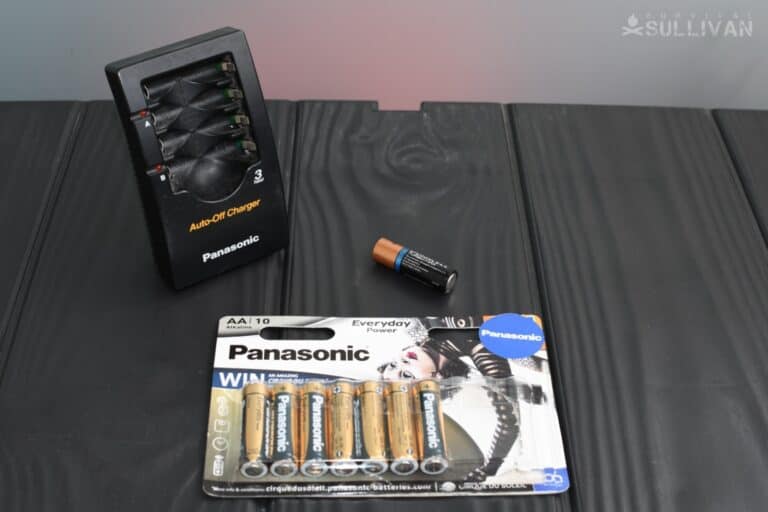
Batteries: Flashlights won’t work without batteries, and whether you have models using an internal rechargeable battery or one’s relying on disposable cells, make sure you have batteries or chargers enough to feed them for the duration and never use them flippantly.
Electricity is a precious resource in a survival situation!
Candles: Candles are a reliable and inexpensive standby for survival lighting but the greatest care must be employed when they are left about lit, especially if you have kids or pets.
Chemlights: Chemlights, also known as snap lights, are a completely safe, heatless self-contained lighting system that are ideal for soft area lighting, signaling, trail marking and more.
Available in a variety of sizes and a variety of colors, you definitely won’t regret having a couple of these in your pack as a last resort or a specialized lighting tool. Plus, their sci-fi glow has a great knack for cheering up scared or anxious children.
Fire Kit
The ability to make fire is one that mankind has enjoyed for ages now, and though we take it for granted it is no less important today, especially in a survival scenario.
Your 72-hour kit should include a small but robust fire starting kit so that you may create a usable cookfire, campfire or signaling fire with a minimum of fuss.
Lighters: We need to get a fire going in a hurry in a survival situation, and that means that there will rarely be a better, more reliable or more convenient tool than a lighter for that purpose.
You can invest in a specialized survival lighter or just toss a couple of Bics into your kit. They will work reliably in all but the coldest environments.
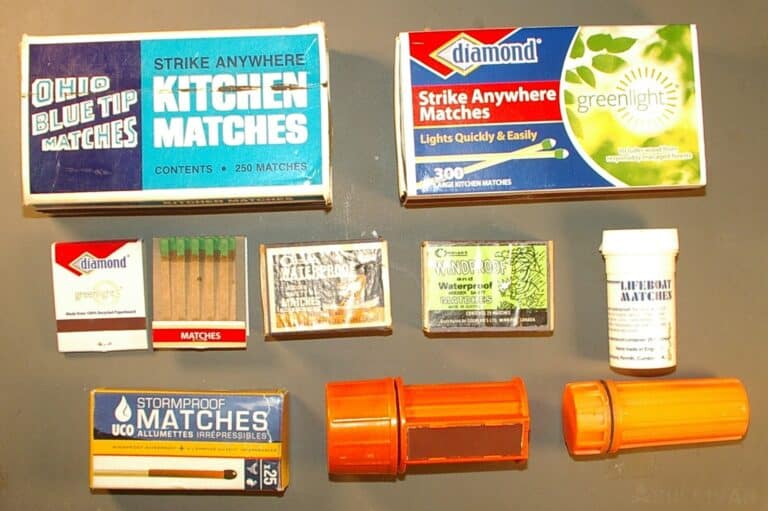
Matches: Matches, especially strike anywhere matches, are always a worthwhile inclusion to your fire starting complement.
If you are worried about them getting wet, or you live in a typically wet environment, invest in specially constructed storm or survival matches that will withstand total immersion in water and still strike reliably.
Ferro Rod: The classic survivalists firestarter, a ferro rod or its close cousin the flint and steel requires a little bit of practice to nail the “sweet spot” of usage, but is incredibly capable in all environments, even wet and nasty ones.
The basic components are so small, light and convenient they are often integrated into necklaces or survival bracelets.
Tinder: Many environments will provide an abundance of wood or other natural materials for fuel, but good, quality tinder is often in short supply or unusably wet.
Considering it weighs next to nothing and takes up next to no space, you are well advised to bring your own with you. Dryer lint, crushed corn chips and sliced up strips of bicycle inner tube are some of my favorites that are basically free.
Navigation Gear
Considering that you might not be living or traveling alone in a survival situation, or are desperately trying to raise help or contact loved ones, the inclusion of communications gear in your 72-hour kit is a wise move.
Additionally, no matter how well you think you know the surrounding area, be it in your county or your city, a smart prepper always includes navigational aids in their survival kit.
Maps: The usefulness of a map should be self-explanatory to any prepper. Choose your map based on your lifestyle, your travels and your anticipated survival objectives. This could be a road atlas, City map, topographical map or a couple different maps. Waterproofing them is a good idea.
Compass: A compass will give you reliable direction finding information, and in conjunction with your maps and a little bit of skill, get you where you need to go, wherever that is.
A proper field compass is an advantage, but most folks can get around well enough using major landmarks and a small button compass in conjunction with their map.
GPS: A GPS system, though sometimes divided as an unreliable piece of technological wizardry in an emergency, is invaluable during a survival situation, especially one when you need to reach a safe haven or get home via a circuitous route.
In all but the most apocalyptic disasters, the intricate systems responsible for the operation of a handheld GPS are likely to remain so, so make sure you have batteries enough to keep it running.
Communications Gear
Cell Phone: Your average smartphone is a precious commodity during a survival situation, and in major regional or national disasters the airwaves will probably be clogged with traffic, but it is still worth trying to contact people via calls, texts and emails.
It has a host of other useful survival functions for preppers that we have talked about here on this website previously.
Radio / Walkie-Talkie: Radios are in many ways a better option for communications in a disaster scenario since they are self-contained whereas cell phones are not. A handheld GMRS radio or high quality walkie-talkie is especially valuable if you are traveling in a group or trying to raise help in the meantime.
Chargers/Batteries as appropriate: Again, reliance on any electronic device means you must be prepared to keep it powered up. Bring with you disposable batteries or a solar recharger as appropriate.
Medical
They don’t call it a survival situation for nothing. You’ll have plenty of opportunities to get hurt in your travels, or if you are unfortunate you might even start out the scenario injured from whatever happened.
Considering emergency services will be entirely unreachable or overwhelmed you must be prepared for caring for yourself and others, and that means you’ll need a thoughtfully equipped medical kit as well as the skills to use it.
Gauze, roll and pad: Useful for treating a variety of lacerating and penetrating injuries.
Gauze, hemostatic: As above, but for major injuries that are bleeding severely. This will help to staunch the flow, but once it is applied you’ll need some skill to remove it without further aggravating a wound. There are many varieties each with pros and cons.
Band-aids: Even small and seemingly inconsequential injuries can take on a life-threatening new context should they become infected. it happens a lot more often and a lot more easily than you might think in the middle of a survival scenario, so use a Band-Aid to keep those small boo-boos clean.
Wound wash: An antiseptic wound wash will get foreign debris out of most injuries while killing the germs that might already be lurking within. Keep a bottle in your kit and use it judiciously.
OTC Meds: A battery of over-the-counter medications in separate containers or single-use packets are a worthwhile inclusion. Get stuff for fever, allergy, nausea and general pain relief. Remember that medications go bad over time, so rotate them periodically.
Prescription Meds: If you suffer from any ongoing health conditions or are currently taking regular prescription medication, you must include the required doses in your medical kit. talk to your doctor about plusing-up your prescription for the purpose.
Latex Gloves: Bloodborne pathogens are no joke, and even if someone or yourself are not currently infected, blood is nasty and biohazardous on its own. more importantly when treating a substantial wound you don’t want germs from your own hands getting in contact with the body behind the barrier of the skin.
TQ: Short for “tourniquet.” Tourniquets do one thing, and that is stop someone from bleeding to death due to an extremity hemorrhage.
Extremity hemorrhages are extremely common in wounds resulting from combat or accident, but luckily easy to treat if you have a tourniquet. I highly recommend the CAT, but get trained and make sure you know how to use it, both applying it to yourself and others.
Hygiene
Toothbrush and Toothpaste: Self-explanatory.
Soap: Self-explanatory. Bar soap is useful for all kinds of washing and cleaning tasks where body washes might not be.
TP/Baby Wipes: TP is self-explanatory. A package of baby wipes will help you stay clean while on the move and also serve double duty as toilet paper.
No water required. Even if you focus solely on the trouble spots of your body, specifically under the armpits, the groin, the feet and your rear end you’ll go a long way towards holding nasty germs at bay and feeling good.
Foot and Body Powder: Moisture causes blisters and blisters can turn into total showstoppers if you are moving by foot. Help prevent blisters while keeping moisture at bay by using a quality foot and body powder. you don’t need a huge bottle, just enough to get you through a rough couple of days.
Hand Sanitizer: Your hands are really going to be working overtime in this survival scenario, and with water being at such a premium you might not want to waste it, per se, for hand washing.
A small bottle of high test alcohol hand sanitizer will reliably nuke every single germ hiding out on your hands just waiting to infect you or someone else.
Feminine Hygiene Products: Self-explanatory. You might not have any need of them but someone you know might.
Weapons
It is a sad fact of life that you might have to defend yourself from others in a survival scenario. It could be criminals running amok because of the collapse of law, or it might be other desperate survivors will do anything to obtain the resources that you have in order to keep on living. Plan accordingly.
Handgun: Assuming you don’t already carry a handgun habitually for self-defense, including one in your 72-hour survival kit is a good idea.
Even something like a reliable .22 caliber semi-automatic can prove more than adequate in the role of a break contact weapon. Larger calibers might seem more attractive but their ammunition will prove to be far heavier, limiting what you can carry easily should you need to bug out.
Long Gun: I generally do not recommend the inclusion of a long gun as part of a 72-hour survival kit if evacuation, especially by foot, is a possibility.
Long guns are heavy, bulky and generally impossible to hide, all liabilities in the vast majority of survival scenarios. However, if you’ve made up your mind on carrying one, choose a rifle or shotgun as desired and appropriate for the environment.
Remember, a 72-hour kit is not designed to keep you fighting through the end of the world or sustaining long enough where hunting for food becomes a concern. We are worried about defending ourselves from aggressive two-legged critters, not bagging animals.
Ammo w/ Feeding Devices: Guns are no good without ammunition to feed them. Include a small quantity of ammunition (100-200 rounds) in your kit and magazines or other feeding devices as appropriate to help you manage the ammo and to get it moving swiftly into the gun when required.
Cash
A somewhat contentious inclusion, I never pack a 72-hour kit without including a dedicated chunk of cash in it. During a major crisis, money still talks and might get you a favor you desperately need.
It could be a ride, safe passage, vital resources or just a good old-fashioned bribe. However much you want to carry is up to you.
You don’t want your 72-hour kit to be a valuable piggy bank for some robber who winds up stealing it, but neither do you want to be heading into a bad situation with only a crumpled Jackson stashed in a pocket, either.
Conclusion
A 72-hour survival kit is an invaluable commodity during all kinds of survival situations when you have little to no time to react.
Containing everything you need to sustain life in a variety of environments and scenarios, it serves as a foundational prep in the quest to obtain personal readiness. Use the checklist provided above as a guide to build your own.
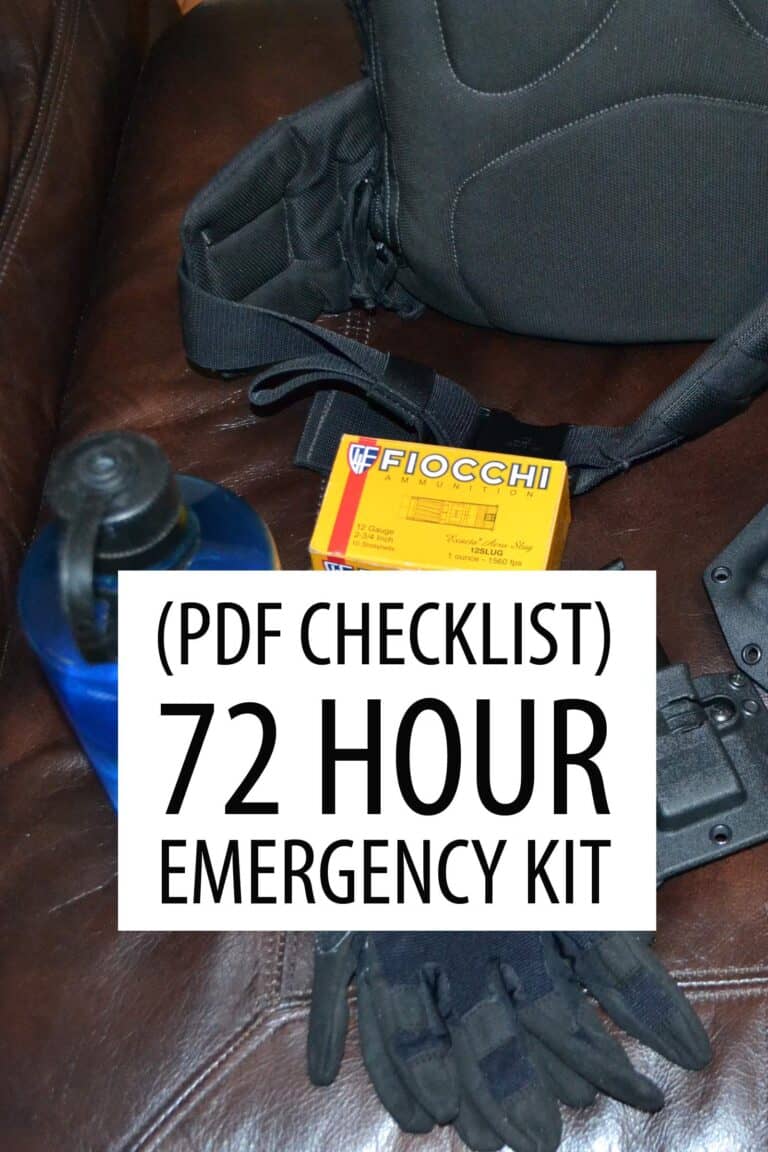

Tom Marlowe practically grew up with a gun in his hand, and has held all kinds of jobs in the gun industry: range safety, sales, instruction and consulting, Tom has the experience to help civilian shooters figure out what will work best for them.

Who could carry all of this if needed? Don’t get me wrong, we have all of it on the farm, but could not even think of carrying this with out the motor home or Jeep ( we have 2).